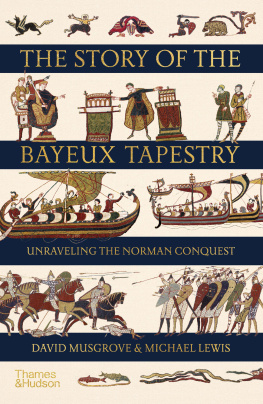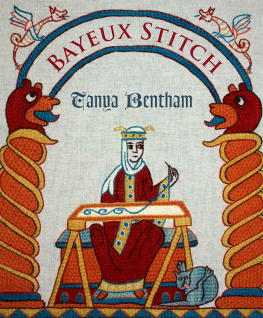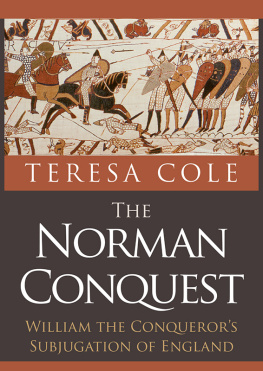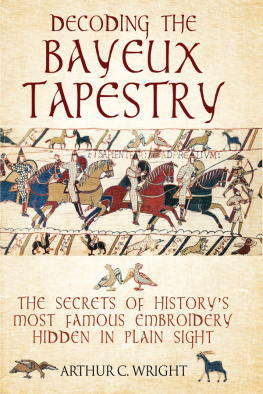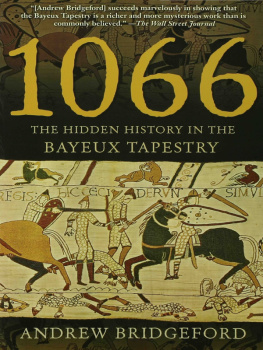Earl of Kent Odo - The man behind the Bayeux Tapestry : Odo, William the Conquerors half-brother
Here you can read online Earl of Kent Odo - The man behind the Bayeux Tapestry : Odo, William the Conquerors half-brother full text of the book (entire story) in english for free. Download pdf and epub, get meaning, cover and reviews about this ebook. City: France--Bayeux., Array, year: 2013, publisher: The History Press, genre: Non-fiction. Description of the work, (preface) as well as reviews are available. Best literature library LitArk.com created for fans of good reading and offers a wide selection of genres:
Romance novel
Science fiction
Adventure
Detective
Science
History
Home and family
Prose
Art
Politics
Computer
Non-fiction
Religion
Business
Children
Humor
Choose a favorite category and find really read worthwhile books. Enjoy immersion in the world of imagination, feel the emotions of the characters or learn something new for yourself, make an fascinating discovery.

- Book:The man behind the Bayeux Tapestry : Odo, William the Conquerors half-brother
- Author:
- Publisher:The History Press
- Genre:
- Year:2013
- City:France--Bayeux., Array
- Rating:5 / 5
- Favourites:Add to favourites
- Your mark:
- 100
- 1
- 2
- 3
- 4
- 5
The man behind the Bayeux Tapestry : Odo, William the Conquerors half-brother: summary, description and annotation
We offer to read an annotation, description, summary or preface (depends on what the author of the book "The man behind the Bayeux Tapestry : Odo, William the Conquerors half-brother" wrote himself). If you haven't found the necessary information about the book — write in the comments, we will try to find it.
Earl of Kent Odo: author's other books
Who wrote The man behind the Bayeux Tapestry : Odo, William the Conquerors half-brother? Find out the surname, the name of the author of the book and a list of all author's works by series.
The man behind the Bayeux Tapestry : Odo, William the Conquerors half-brother — read online for free the complete book (whole text) full work
Below is the text of the book, divided by pages. System saving the place of the last page read, allows you to conveniently read the book "The man behind the Bayeux Tapestry : Odo, William the Conquerors half-brother" online for free, without having to search again every time where you left off. Put a bookmark, and you can go to the page where you finished reading at any time.
Font size:
Interval:
Bookmark:

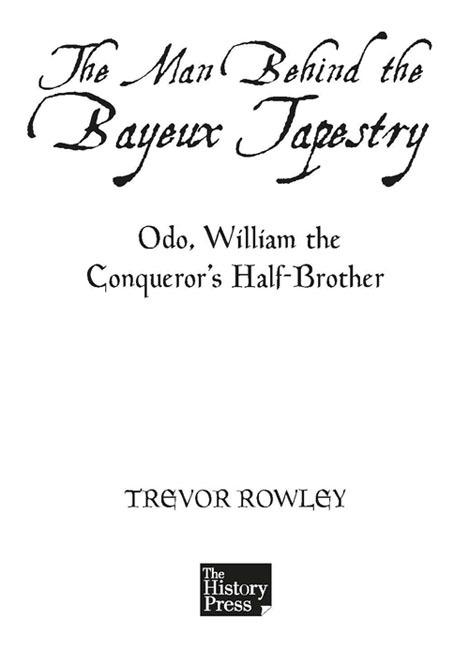
Odo of Conteville was a larger than life character, who is best known for his dashing appearance on the Bayeux Tapestry as a mounted cleric waving a baton at the height of the Battle of Hastings. In older text books the bishop is frequently characterised in terms of illegally obtaining land from English monastic houses and of rebelling against the king. Generally he is portrayed as a not so loveable rogue, who typified the worst excesses of the Norman conquerors. In recent decades the work of David Bates and others has done much to redress the balance of opinion about Odo amongst historians, but the popular impression of William the Conquerors half-brother still remains largely a narrow and negative one.
I have spent most of my life working within extra-mural departments, whose task was to make scholarship generated largely within universities, accessible to the world outside. The aim of this book is just that, to try to make Bishop Odos extraordinary life-story known to a wider audience. In the past I could have anticipated that my book would find its way into the book boxes of the lifelong-learning classes held in towns and villages throughout the country. Sadly such commendable educational activity now appears somewhat archaic and is indeed itself largely historical in character. It would be preposterous for me to try to enlist Odo as a prescient supporter of the great extra-mural tradition, but it should be remembered that he was far from being a loutish philistine. The bishop recognised the value of education and the arts and amongst his less well-known activities was his generous patronage of both.
Trevor Rowley
Appleton (one of Bishop Odos estates recorded in Domesday Book), Oxfordshire, 30 November 2012
Thanks are due to those many people who encouraged me to write this book and have helped with information, ideas, typing, translating, editing and drawing. Notably Richard Allen, Pat Combs, Susannah Dyer, Linda Kent, Francoise Laval, Tony Morris, Richard Rowley, Lindsey Smith, Alison Wilkinson snd my wife Jane Rowley.
Thanks are also due to the following individuals and organisations for their kind permission to reproduce illustrations: English Heritage (colour plates 11, 23 and 25, and figure 42), Francoise Laval (colour plate 10), and Alison Wilkinson (figures 4, 11, 22, 36, 41 and 51).
The name of Odo is one which will be found constantly recurring in this history, from the day when his bishops staff and warriors mace were so successfully wielded against the defenders of England, till the day when he went forth to wield the same weapons against the misbelievers in the East and found in his road a tomb, far from the heavy pillars and massive arches of his own Bayeux, among the light and gorgeous enrichments with which the conquered Saracen knew how to adorn the palaces and churches of the Norman lords of Palermo.
So wrote the venerable Victorian historian, Edward Augustus Freeman in his magisterial account of the History of the Norman Conquest (187478, 210).
Odo de Conteville, whose name also appears in the form of Odon, Eudo and Eudes, was born in around 1030 in Normandy. He was the half-brother of William the Conqueror and, as Freeman proclaims, Odos name reverberates throughout the narrative of Anglo-Norman history in the eleventh century. He became Bishop of Bayeux while still in his teens, a position he was to hold until his death. He helped plan the invasion and participated in the Battle of Hastings and the subsequent Conquest of England. He became Earl of Kent with responsibility for the defence of south-east England; he was regent to King William from time to time on the kings frequent visits to Normandy. Odo gained land legally and illegally after the Conquest and his English estates and wealth were second only to the Conquerors. He was responsible for the building and consecration of a new cathedral at Bayeux. He developed a powerful cathedral chapter which nurtured many leading figures among the Anglo-French clergy. He sponsored artists, musicians and poets and is widely believed to have been responsible for the making of the Bayeux Tapestry. In 1082 he raised a private army in England with the intention of acquiring the papacy, for which he was arrested and imprisoned for four years by King William. On his release he almost immediately rebelled against the new king, William Rufus, and as a consequence was permanently banished from England. In 1096 he joined Duke Robert Curthoses contingent leaving Normandy on the First Crusade and died a natural death in Palermo, Sicily, early in 1097. These are the compelling headlines for a life that touched on almost every aspect of the Anglo-Norman story in the eleventh century.
The Duchy of Normandy was barely a century old when Odo was born, and its rulers had only called themselves dukes for a few decades. The duchy had been carved out of Neustria, a post-Romano-Gallic territory of fluctuating dimensions lying between and including the Seine and the Loire valleys. Neustria originated in the Merovingian fifth century, but by AD 900 it had been moulded to create a buffer territory of the decaying Western Carolingian Empire. In the mid-ninth century, Charles the Bald, King of the Western Franks had carved Maine and Angers out of Neustria in order to confront the Bretons, who at that time were the most serious threat to the Western Franks. Towards the end of the ninth century it was the Vikings who posed the most danger, and the fertile river estuaries of western France, notably, the Loire, Seine and Somme, provided Viking attackers with ready access to inland regions. Pillage and plunder in the Seine Valley in the late ninth century was followed by permanent Scandinavian settlements and eventually by the acquisition of territory in the tenth. Short-lived Viking enclaves were also established in the estuaries of the Loire and the Rhine, but it was only the Northmanni in the Seine Valley who were able to create a more permanent political entity on mainland Europe.
Although the detailed history of Normandys origins is far from clear, the traditional story is that in 911, Charles the Simple, King of the West Franks ceded an area of the Seine Valley around Rouen to a Viking warlord called Rollo. This territory, which coincided with the old Frankish diocese of Rouen, was granted to the Northmanni in a treaty signed at St-Clair-sur-Epte on the eastern boundary of what was to become Normandy. Reputedly, Rollo converted to Christianity in return for defending the Seine Valley against further Viking attacks. Rollo, known by the title of Count of Rouen, and his son, William Longsword, acquired overlordship of most of the rest of the geographical area that became the Duchy of Normandy during the next thirty years.
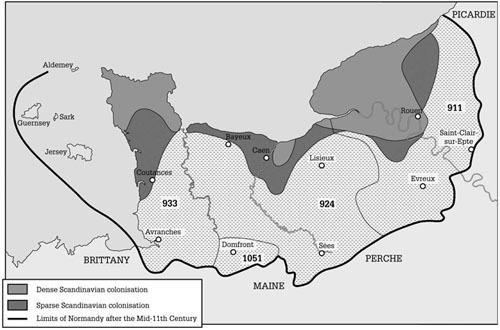
1 Map showing the dates at which land was ceded from the Western Empire to the dukes of Normandy. Ducal authority did not operate fully in the whole of the duchy until the eleventh century. After the Museum of Normandy, Caen
It is probable that the Franks did not view Normandy as a permanent creation, and when in 921 an attempt by the Western Franks to bring the Normans to heel failed, a network of semi-independent seigneuries was established to act as a buffer, the most notable of which was Bellme, to the south of the duchy. During the later tenth century these territories drifted under Norman influence, although eventually they were to pose serious problems for the Norman dukes (Dunbabin 1985, 667). By the early eleventh century the duchy had begun to resemble its neighbours in northern and western France in many ways, but it had still not fully recovered from the physical and cultural damage inflicted by the Vikings and was still in the process of acquiring the military, governmental and artistic features that were to form its most distinguishing characteristics. Odos story was an integral part of a larger narrative about a territory that was still in the process of repairing and re-creating itself. Although Normandy was recognised as being under ducal overlordship in the late tenth century, the dukes authority did not necessarily extend throughout the whole territory. There were semi-autonomous warlords, operating in the west in particular, until the early eleventh century and it was not until the reign of Richard II (9961026) that Normandy became a largely unified duchy.
Font size:
Interval:
Bookmark:
Similar books «The man behind the Bayeux Tapestry : Odo, William the Conquerors half-brother»
Look at similar books to The man behind the Bayeux Tapestry : Odo, William the Conquerors half-brother. We have selected literature similar in name and meaning in the hope of providing readers with more options to find new, interesting, not yet read works.
Discussion, reviews of the book The man behind the Bayeux Tapestry : Odo, William the Conquerors half-brother and just readers' own opinions. Leave your comments, write what you think about the work, its meaning or the main characters. Specify what exactly you liked and what you didn't like, and why you think so.



